Greek Architecture › Ancient Iranian Salt Mine Mummies » Origins and History
Articles and Definitions › Contents
- Greek Architecture › Ancient History
- Ancient Iranian Salt Mine Mummies › Antique Origins
Ancient civilizations › Historical places, and their characters
Greek Architecture › Ancient History
Definition and Origins
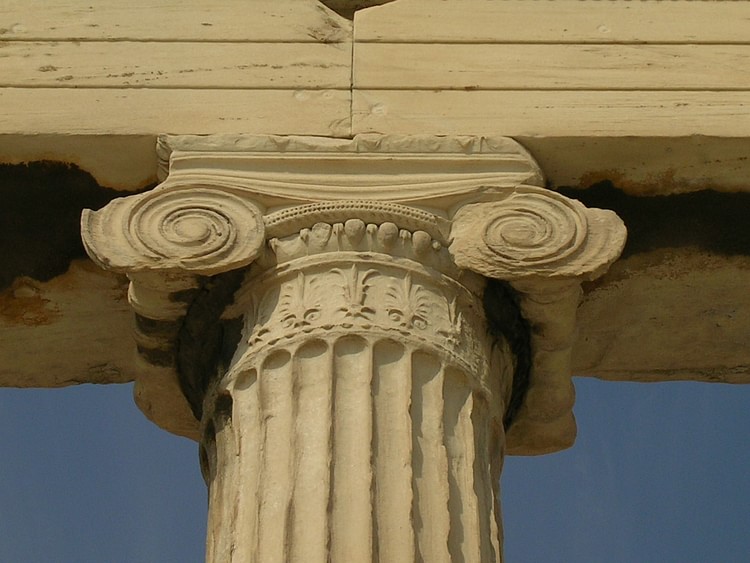
Greek architects provided some of the finest and most distinctive buildings in the entire Ancient World and some of their structures, such as temples, theatres, and stadia, would become staple features of towns and cities from antiquity onwards. In addition, the Greek concern with simplicity, proportion, perspective, and harmony in their buildings would go on to greatly influence architects in the Roman world and provide the foundation for the classical architectural orders which would dominate the western world from the Renaissance to the present day.
THE ARCHITECTURAL ORDERS
There are five orders of classical architecture - Doric, Ionic, Corinthian, Tuscan, and Composite - all named as such in later Roman times. Greek architects created the first three and hugely influenced the latter two which were composites rather than genuine innovations. An order, properly speaking, is a combination of a certain style of column with or without a base and an entablature (what the column supports: the architrave, frieze, and cornice). The earlier use of wooden pillars eventually evolved into the Doric column in stone. This was a vertical fluted column shaft, thinner at its top, with no base and a simple capital below a square abacus. The entablature frieze carried alternating triglyphs and metopes. The Ionic order, with origins in mid-6th century BCE Asia Minor, added a base and volute, or scroll capital, to a slimmer, straighter column. The Ionic entablature often carries a frieze with richly carved sculpture. The Corinthian column, invented in Athens in the 5th century BCE, is similar to the Ionic but topped by a more decorative capital of stylized acanthus and fern leaves. These orders became the basic grammar of western architecture and it is difficult to walk in any modern city and not see examples of them in one form or another.

Corinthian Capital
MATERIALS
The Greeks certainly had a preference for marble, at least for their public buildings. Initially, though, wood would have been used for not only such basic architectural elements as columns but the entire buildings themselves. Early 8th century BCE temples were so constructed and had thatch roofs. From the late 7th century BCE, temples, in particular, slowly began to be converted into more durable stone edifices; some even had a mix of the two materials. Some scholars have argued that certain decorative features of stone column capitals and elements of the entablature evolved from the skills of the carpenter displayed in more ancient, wooden architectural elements.
The stone of choice was either limestone protected by a layer of marble dust stucco or even better, pure white marble. Also, carved stone was often polished with chamois to provide resistance to water and give a bright finish. The best marble came from Naxos, Paros, and Mt. Pentelicon near Athens.
TEMPLES, TREASURIES & STOAS
ARCHITECTS USED SOPHISTICATED GEOMETRY AND OPTICAL TRICKS TO PRESENT BUILDINGS AS PERFECTLY STRAIGHT AND HARMONIOUS.
The ancient Greeks are rightly famous for their magnificent Doric and Ionic temples, and the example par excellence is undoubtedly the Parthenon of Athens. Built in the mid 5th century BCE in order to house the gigantic statue of Athena and to advertise to the world the glory of Athens, it still stands majestically on the city's acropolis. Other celebrated examples are the massive Temple of Zeus at Olympia (completed c. 460 BCE), the Temple of Artemis at Ephesus (completed c. 430 BCE), which was considered one of the wonders of the ancient world, and the evocative Temple of Poseidon at Sounion (444-440 BCE), perched on the cliffs overlooking the Aegean. The latter is illustrative of the Greek desire that such public buildings should not just fulfil their typical function of housing a statue of a Greek deity, and not only should they be admired from close-up or from the inside, but also that they should be admired from afar. A great deal of effort was made to build temples in prominent positions and, using sophisticated geometry, architects included optical 'tricks' such as thickening the lower parts of columns, thickening corner columns, and having columns ever so slightly lean inwards so that from a distance the building seemed perfectly straight and in harmony. Many of these refinements are invisible to the naked eye, and even today only sophisticated measuring devices can detect the minute differences in angles and dimensions. Such refinements indicate that Greek temples were, therefore, not only functional structures but also that the building itself, as a whole, was symbolic and an important element in the civic landscape.

Temple of Hera, Selinus
Greek temples, at least on the mainland, followed a remarkably similar plan and almost all were rectangular and peripteral, that is their exterior sides and façades consisted of rows of columns. Notable exceptions included the magnificently eccentric Erechtheion of Athens with its innovative Caryatid columns and the temples of the Cyclades which, although still Doric, only had columns on the front façade (prostyle), which was often wider than the length of the building. So too, temples from Ioniatended to differ from the norm, usually having a double colonnade (dipteral). However, returning to the standard Greek temple layout, the rectangular peristyle of columns (8 x 17 in the case of the Parthenon, 6 x 13 for the temple of Zeus at Olympia) surrounded an inner chamber or cella with the whole standing on a stepped platform or stylobate and the interior paved with rectangular slabs. The roof was usually raised along a central ridge with a slope of approximately 15 degrees and was constructed from wooden beams and rafters covered in overlapping terracotta or marble tiles. Decorative acroteria (palms or statues) often stood at each point of the pediment. Finally, the doors to temples were made of wood (elm or cypress) and often decorated with bronze medallions and bosses.
Many temples also carried architectural sculpture arranged to tell a narrative. Pediments, friezes, and metopes all carried sculpture, often in the round or in high relief and always richly decorated (with paint and bronze additions), which retold stories from Greek mythology or great episodes in that particular city's history.
Temples also indicate that Greek architects ( architektones ) were perfectly aware of the problems of providing stable foundations able to support large buildings. Correct water drainage and the use of continuous bases on foundations above various layers of fill material (conglomerate soft rocks, soil, marble chips, charcoal, and even sheepskins) allowed large Greek buildings to be built in the best positions regardless of terrain and to withstand the rigours of weather and earthquake over centuries. Indeed, absolute stability was essential, as even a slight settling or subsidence in any part of the building would render useless the optical refinements discussed above. It is remarkable that the vast majority of Greek buildings that have collapsed have done so only because of human intervention - removing blocks or metal fixtures for reuse elsewhere - weakening the overall structure. Structures not interfered with, such as the Temple of Hephaistos in the Athens agora, are testimony to the impressive durability of Greek buildings.
Other structures which were constructed near temples were monumental entrance gates (such as the Propylaia of Athens' acropolis) and small buildings to house dedications, often from specific city-states. These very often borrowed architectural elements from the temple such as columned façades and friezes. An excellent example is the Treasury of the Athenians at Delphi (490 BCE).
The stoa was another structure common to many temple complexes from the 7th century BCE onwards. This was a long, narrow row of columns backed by a plain wall and roofed. Often placed at right-angles to create an enclosed open space, stoas were used for all manner of purposes such as meeting places and storage. The agora or market place of many ancient Greek towns would be composed of a large open square surrounded by a stoa. One unusual stoa is that of the Sicilian colony of Selinus. This was constructed between 580 and 570 BCE and was a trapezoid in shape. More interestingly, the nearby shops all present the same façade despite being different types of buildings. This is evidence that there was some sort of centrally controlled planning authority which ensured harmony of architecture in important public places. Certainly, during the 5th century BCE there were professional town planners, the most famous of which was Hippodamos who is often credited with planning the Piraeus and Rhodes. Interestingly, there is very often a correspondence between architectural changes in towns and changes in political regime. One final function of the stoa in Hellenistic times was in the gymnasium and palaistracomplexes, notably at the great sanctuaries of Olympia, Delphi, and Nemea. These stoas were used to create an enclosed space for physical exercise and provide a practice area for such field events as the javelin and discus.
Temples, treasuries, and stoas then, with their various orders and arrangements of columns have provided the most tangible architectural legacy from the Greek world, and it is perhaps ironic that the architecture of Greek religious buildings has been so widely adopted in the modern world for such secular buildings as court houses and government buildings.
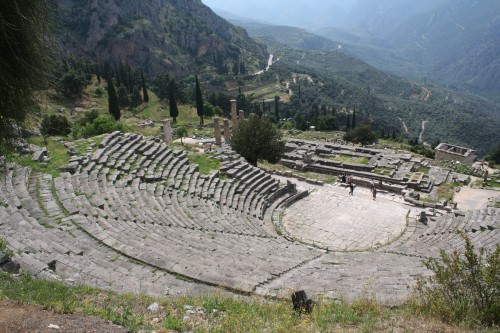
Theatre of Delphi
THE THEATRE
Another distinctive Greek contribution to world culture was the amphitheatre. The oldest certain archaeological evidence of theatres dates from the late 6th century BCE but we may assume that Greeks gathered in specified public places much earlier.Indeed, Bronze Age Minoan sites such as Phaistos had large stepped-courts which are thought to have been used for spectacles such as religious processions and bull-leaping sports. Then from the late 6th century BCE we have a rectangular theatre-like structure from Thorikos in Attica which had a temple dedicated to Dionysos at one end. This would suggest it was used during Dionyistic festivals, at which dramas were often presented. However, it was from the 5th century BCE that the Greek amphitheatre took on its recognisable and most influential form. This was an open-air and approximately semi-circular arrangement of rising rows of seats ( theotron ) which provided excellent acoustics. The stage or orchestra was also semi-circular and backed by a screen or skene, which would become more and more monumental in the following centuries.Monumental arches often provided the entrances ( paradoi ) on either side of the stage.
Examples abound throughout the Greek world and many theatres have survived remarkably well. One of the most celebrated is the theatre of Dionysus Eleutherius on the southern slope of Athens' acropolis where the great plays of Sophocles, Euripedes, Aeschylus, and Aristophanes were first performed. One of the largest is the theatre of Argos which had a capacity for 20,000 spectators, and one of the best preserved is the theatre of Epidaurus which continues every summer to host major dramatic performances. Theatres were used not only for the presentation of plays but also hosted poetry recitals and musical competitions.
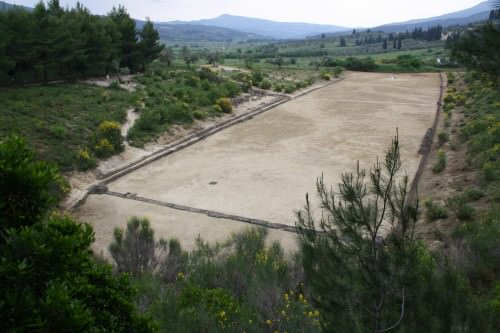
Ancient Stadium, Nemea, Greece
THE STADIUM
Another lasting Greek architectural contribution to world culture was the stadium. Stadiums were named after the distance (600 ancient feet or around 180 metres) of the foot-race they originally hosted - the stade or stadion. Initially constructed near natural embankments, stadia evolved into more sophisticated structures with rows of stone or even marble steps for seating which had divisions for ease of access. Conduits ran around the track to drain off excess rainfall and in Hellenistic times vaulted corridors provided a dramatic entrance for athletes and judges. Famous examples include those at Nemea and Olympia which had seating capacities of 30,000 and 45,000 spectators respectively.
HOUSING
Considering more modest structures, there were fountain houses (from the 6th century BCE) where people could easily collect water and perhaps, as black-figure pottery scenes suggest, socialise. Regarding private homes, these were usually constructed with mud brick, had packed earth floors, and were built to no particular design. One- or two-storied houses were the norm. Later, from the 5th century BCE, better houses were built in stone, usually with plastered exterior and frescoed interior walls. Also, there was often no particular effort at town planning which usually resulted in a maze of narrow chaotic streets, even in such great cities as Athens. Colonies in Magna Graecia, as we have seen in Selinus, were something of an exception and often had more regular street plans, no doubt a benefit of constructing a town from scratch.
In conclusion then, we may say that ancient Greek architecture has provided not only many of the staple features of modern western architecture, but it has also given the world truly magnificent buildings which have literally stood the test of time and continue to inspire admiration and awe. Many of these buildings - the Parthenon, the Caryatid porch of the Erechtheion, the volute of an Ionic capital to name just three - have become the instantly recognisable and iconic symbols of ancient Greece.
Ancient Iranian Salt Mine Mummies › Antique Origins
Ancient Civilizations
As a young girl interested in archaeology and history, mummies always intrigued me. From the intricate Egyptian mummies to the naturally and beautifully preserved mummies of the Incas, they seemed to me to be beautiful pieces of art containing secrets of the ancient past. So imagine the disappointment I felt, when at the tender age of eight, I realised that the Persians did not have any mummies! Actually very few human remains have been found in the Iranian Plateau. The Royal Achaemenidtombs in Naghshe Rostam yielded their treasures and human remains many centuries ago. The Sasanians and the Achaemenids for that matter, made funerary archaeology a bit more difficult by practising the Zoroastrian mortuary rituals, which left very little or no human remains to be studied by archaeologists.
Now and then a chance discovery of a “Royal Persian Mummy” would hit the news, and of course later would turn out to be a fake. The most famous of these is the “Royal Princess-Mummy” thought to be a daughter of Xerxes, this particular mummy was on sale on the black market for about 11 million dollars! But of course this “amazing find”, which was thought to be the Tutankhamun of the Achaemenid Empire, almost lead to an international incident involving Iran, Pakistan, and even the Taliban in Afghanistan. All this was more or less due to the curator of the National Museum in Karachi, where “the Royal Princess” was being held and stored. Being overwhelmed by this find of the century, Asma Ibrahim thought she could read the cuneiform inscriptions on the mummy's gold plaque herself, ordered numerous CT scans, and also assisted in its autopsy.However, she forgot one key fact. There are no records nor evidence that the Achaemenids, who followed an early type the Zoroastrian faith, would want or need an embalming according to the Egyptian ritual customs. (The only remote mention of a possible embalming in ancient Persia is from Herodotus, who mentions that the Persians embalmed their dead in wax. Hdt 1.140) Also the pencil marks around the wooden embellishments on the coffin should have given her a clue. The 2600 year old “Royal Princess” turned out to be a woman with dyed blond hair, who had died by having her neck broken in 1996 CE. This poor, middle-aged woman was either a victim of grave robbery or was murdered in a “mummy factory” somewhere between Iran and Pakistan.
After this disappointment, I came across “The Iranian Saltmen”, and I was pleasantly surprised. The “Saltmen of Zanjan” were preserved by a very rare form of natural mummification which had occurred in a salt mine.
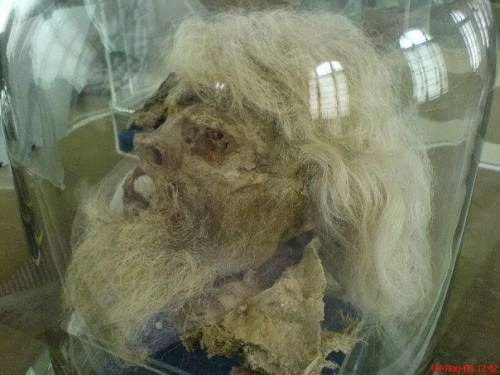
Original Saltman Mummy
In 1993 CE miners in the Douzlakh Salt Mine, near Hamzehli and Chehr Abad villages in Zanjan Province, accidentally came across a mummified head. The head was very well preserved, to the extent that his pierced ear was still holding the gold earring. The hair, beard, and the moustaches were reddish in colour, and his impressive leather boot still contained parts of his leg and foot.
The local Zanjan branch of the Miras Farhangi (Zanjan Cultural Heritage, Handicrafts and Tourism Organisation) was called, and they performed a rescue excavation and found three iron knives, a pair of short trousers made of wool, a silver needle, a sling, a leather rope, a grindstone, some pottery shards, patterned textile fragments, a few broken bones, and even a walnut.He was found in a middle of a tunnel, about 45 metres in length.

Saltman's Leather Boot
The local Zanjan branch of the Miras Farhangi, thinking that this mummy was an individual find, did not investigate the mine any further. However, in 2004 CE the miners discovered yet another “saltman”, and again the local Zanjan branch of the Miras Farhangi was called in. The team discovered further remains of a human body along with a large number of artefacts made of wood, metal tools, clothing, and pottery.
The Miras-e-Farhangi, realising that they might have stumbled upon a mine with a long history of usage, finally got their act together, and started an archaeological investigation, involving several international research organisations:
- Iranian Centre for Archaeological Research (ICAR), Shiraz, Iran
- Ruhr-Universität Bochum
- Universität Zürich, Zentrum für Evolutionäre Medizin
- University of Oxford, (RLAHA Oxford), Research Laboratory for Archaeology & the History of Art
- York University, Institute of Archaeology
- Tehran University, The Institute of Parasitology and Mycology
- Zanjan University, Institute of Geomorphology
- University of Franche-Comte, Faculty of Sciences & Techniques
In 2005 CE a systematic excavation began, three more mummies were excavated, and a sixth remained in situ, due to lack of funds for its storage. The context of the remains suggested that a collapse in the mine had caused the death of the miners in question.
The first mummy, dubbed the "Saltman", is on display in the National Museum of Iran in Tehran. He still looks very impressive, I just wish he was displayed a bit better.
This particular "saltman" was originally dated based on the archaeological material found with him. Sobuti, the Iranian archaeologist who performed the first rescue excavation, suggested a date of around 800 BCE based on the clothing and the accessories found with him, which placed him in the Neo- Elamite Period (1000-539 BCE). Later, the mummy was carbon dated, which placed him in 500 CE (1750 BP, that is, "before present" or 1750 years ago), the height of the Sasanian Empire.The second "saltman" was carbon dated to 1554 BP, which placed him in the same era as the first "saltman", the Sasanianera.
The third, fourth, and the fifth "saltmen" were also carbon dated. The third body was dated and placed in 2337 BP, the fourth body in 2301 BP, and the fifth mummy was dated to 2286 BP, placing them all in the Achaemenid period.

Saltman Mummy from Iranian Mine
However, the previous number of five has since increased to at least 8 individuals. As the further anatomical analysis revealed that the bones previously thought to have belonged to one individual belonged to several more.
The isotopic analysis of the human remains revealed where these miners were from. Some of them were from the Tehran-Qazvin Plain, which is relatively local to the mine's locality, while others were from North-Eastern Iran and the coastal areas around the Caspian Sea, and a few from as far away as Central Asia.
Furthermore, the archaeozoological finds, such as animal bones found within the context of the saltmen, showed that the miners might have eaten sheep, goats, and probably pigs and cattle, as well. The archaeobotanical finds recorded showed different cultivated plants were eaten, indicating an agricultural establishment in the vicinity of the mine.
The wealth of fabric and other organic material (leather) worn by the saltmen have allowed a thorough analysis to be undertaken, detailing the resources used to make the fabrics, the processing, the dyes used to colour the fibres of the garments, and not least they offer an excellent overview of the changes in cloth types, patterns of weaving, and the changes of the fibres through time.
All the data collected so far has allowed the researchers to have the first holistic view of the mine and the miners who worked there through the periods of its usage. The variety of the artefacts and the ecofacts found in each stratigraphic and chronological setting has offered a concise context, hence revealing the differences between the two ancient mining phases.
During the Achaemenid phase, the mining area was accessed from areas further away, indicated by the lack of settlement in the vicinity of the mine, and the presence of foreign miners as indicated by the DNA results from some of the salt mummies.The high number of ceramic vessels and goods supplied also suggest access from further away, while the Sasanian phase shows that the mining was established within the local landscape, and the isotopic data indicates that the supplies were organised on a regional basis.
It is also very interesting to take the lack of any archaeological evidence of any form of a mining settlement within the vicinity of the mine into account, which indicates that the mining was seasonal rather than highly organized. For instance, if we look at the contemporary Greek mining practice by contrast, this was often a task done by slaves and was highly organised.
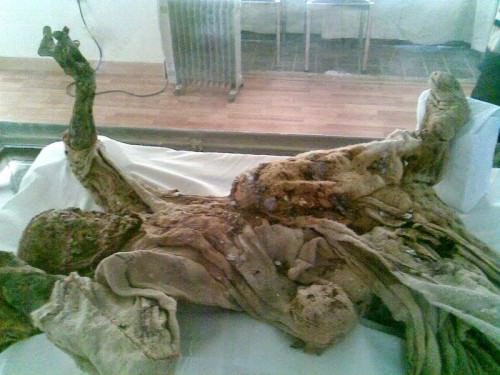
Saltman Mummy No. 4
The individual "Saltmen" have a few secrets of their own, for instance the first "saltman" that was discovered had the blood type B+, and 3D imaging of his skull revealed fractures around his eye and other damage that occurred before death by a hard blow to the head. His clothing (the impressive leather boot) and his gold earring, show a person of some rank; the reason for his presence in the mine still remains a mystery. Was he murdered and dumped there, or was he mining salt and fell victim to a cave in?
Saltman No. 5 had tapeworm eggs from the Taenia sp. genus in his system. These were identified during the study of his remains. The find indicates the consumption of raw or undercooked meat, and this is the first case of this parasite in ancient Iran and the earliest evidence of ancient intestinal parasites in the area. The best preserved and probably the most harrowing of the saltmen is Saltman No. 4. A sixteen-year-old miner, caught in the moment of death, crushed by a cave-in.
For a while it seemed that the four "Saltmen" displayed in the Rakhtshuikhane Museum in Zanjan were in danger of becoming damaged by bacterial infection. The display cases were not sealed properly and were allowing air to enter. Hence there was some damage to the internal organs of some the mummies. However, the Iranian press and the Zanjan Cultural Heritage, Tourism and Handicrafts Dept. director later reported “Without hesitation, I can now say that the salt men kept here are in better condition than the one at the National Museum of Iran in Tehran.” Three cases were made especially for the Saltmen, costing about $25,000 each. The cases are equipped with devices which enables experts to monitor conditions inside and keep them under full control.
The wealth of knowledge these five mummies and the associated finds have brought and are still bringing in understanding Ancient Iran is truly invaluable, and I do hope one day further excavations can be carried out in this mine, so that further discoveries can come to light.
LICENSE:
Article based on information obtained from these sources:with permission from the Website Ancient History Encyclopedia
Content is available under License Creative Commons: Attribution-NonCommercial-ShareAlike 3.0 Unported. CC-BY-NC-SA License